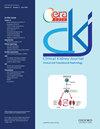Chronic kidney disease-associated pruritus and quality of life with difelikefalin treatment: a post hoc analysis of phase 3 data using the Skindex-10 questionnaire
IF 3.9
2区 医学
Q1 UROLOGY & NEPHROLOGY
引用次数: 0
Abstract
Background Pruritus is a common condition in chronic kidney disease, especially for patients receiving haemodialysis. Chronic kidney disease associated-pruritus (CKD-aP) can be distressing and have a negative impact on quality of life (QoL). This post hoc analysis aimed to assess the relationship between pruritus relief and QoL. Methods Data from phase 3 trials ([NCT03422653, NCT03636269 grouped], and NCT03998163) of the novel antipruritic difelikefalin (N = 914) were used to assess the relationship between reductions in pruritus intensity at Week 12 (24-hour Worst Itching Intensity Numeric Rating Scale; WI-NRS), perceived improvement in itch (Patient Global Impression of Change, PGI-C) and pruritus-related QoL (Skindex-10 questionnaire). Results Patients receiving difelikefalin had greater improvements in Skindex-10 total scores than those receiving placebo (LS mean treatment difference –3.4; 95% CI –5.5, –1.3; P = 0.002) and greater improvements across Skindex-10 domains (disease, mood, and social functioning) at Week 12. In patients receiving difelikefalin, those with clinically meaningful improvements in pruritus (≥3-point reduction in WI-NRS score) at Week 12 had a greater improvement in Skindex-10 total score (mean difference 14.2; 95% CI 11.0, 17.3; P < 0.001) and Skindex-10 domains than those with a < 3-point reduction in WI-NRS score. Improvements in Skindex-10 total scores correlated with PGI-C. Conclusions Improvements in pruritus intensity following 12 weeks’ treatment with difelikefalin were associated with improvements in QoL. Larger improvements in Skindex-10 scores were seen in patients with a greater reduction in pruritus intensity, indicating that improvements in pruritus are associated with a range of factors, such as mood and social functioning, that affect pruritus-related QoL.地匹福林治疗慢性肾病相关瘙痒症和生活质量:使用 Skindex-10 问卷对第 3 阶段数据进行事后分析
背景瘙痒是慢性肾脏病的一种常见症状,尤其是对接受血液透析的患者而言。慢性肾脏病相关性瘙痒症(CKD-aP)会给患者带来痛苦,并对生活质量(QoL)产生负面影响。这项事后分析旨在评估瘙痒缓解与 QoL 之间的关系。方法 采用新型抗瘙痒剂地匹法林(N = 914)3 期试验([NCT03422653、NCT03636269 组]和 NCT03998163)的数据,评估第 12 周时瘙痒强度降低(24 小时最严重瘙痒强度数字评分量表;WI-NRS)、瘙痒改善感(患者总体变化印象,PGI-C)和瘙痒相关 QoL(Skindex-10 问卷)之间的关系。结果 第12周时,接受地匹法林治疗的患者的Skindex-10总分比接受安慰剂治疗的患者有更大改善(LS平均治疗差异-3.4;95% CI -5.5,-1.3;P = 0.002),Skindex-10各领域(疾病、情绪和社会功能)也有更大改善。在接受地匹法林治疗的患者中,与WI-NRS评分减少3分的患者相比,第12周时瘙痒症状有临床意义改善(WI-NRS评分减少≥3分)的患者在Skindex-10总分(平均差14.2;95% CI 11.0,17.3;P< 0.001)和Skindex-10领域的改善幅度更大。Skindex-10总分的改善与PGI-C相关。结论 使用地匹福林治疗 12 周后,瘙痒强度的改善与 QoL 的改善相关。瘙痒强度降低较多的患者的 Skindex-10 评分改善幅度较大,这表明瘙痒的改善与一系列影响瘙痒相关 QoL 的因素有关,如情绪和社会功能。
本文章由计算机程序翻译,如有差异,请以英文原文为准。
求助全文
约1分钟内获得全文
求助全文
来源期刊

Clinical Kidney Journal
Medicine-Transplantation
CiteScore
6.70
自引率
10.90%
发文量
242
审稿时长
8 weeks
期刊介绍:
About the Journal
Clinical Kidney Journal: Clinical and Translational Nephrology (ckj), an official journal of the ERA-EDTA (European Renal Association-European Dialysis and Transplant Association), is a fully open access, online only journal publishing bimonthly. The journal is an essential educational and training resource integrating clinical, translational and educational research into clinical practice. ckj aims to contribute to a translational research culture among nephrologists and kidney pathologists that helps close the gap between basic researchers and practicing clinicians and promote sorely needed innovation in the Nephrology field. All research articles in this journal have undergone peer review.
 求助内容:
求助内容: 应助结果提醒方式:
应助结果提醒方式:


